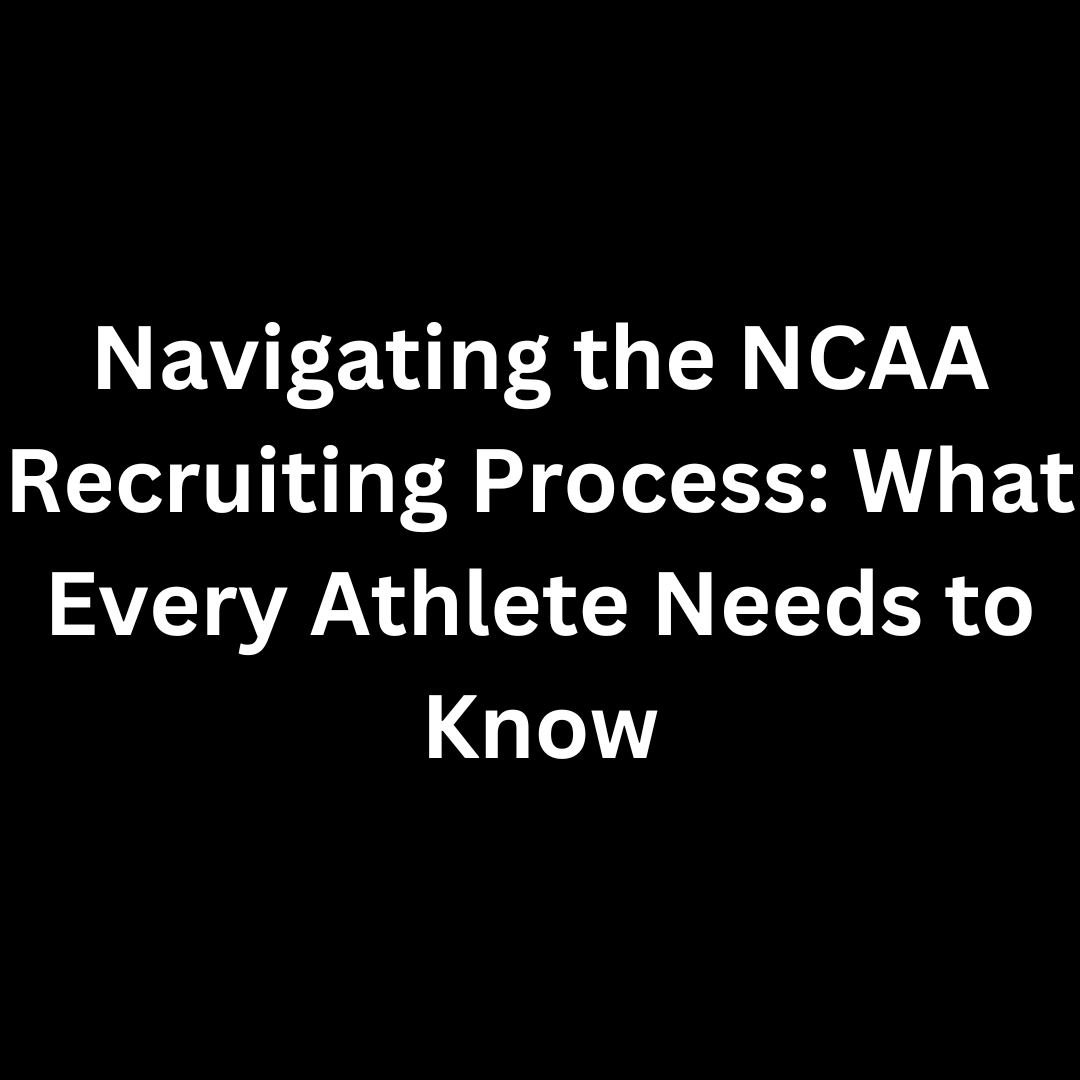For aspiring college athletes, understanding the NCAA recruiting process is crucial. The NCAA (National Collegiate Athletic Association) governs college athletics in the U.S., and its recruiting process is designed to create fairness for athletes, coaches, and programs. However, with different rules, timelines, and eligibility requirements depending on the division and sport, it can be overwhelming for athletes and their families to navigate.
In this article, we’ll break down the key NCAA recruiting rules, timelines, and important steps athletes need to follow to stay on track and make the most of their recruiting journey.
The NCAA Divisions Explained
The NCAA is divided into three divisions, each with its own recruiting guidelines:
- Division I: The most competitive level, known for large schools with well-funded athletic programs. Division I athletes often receive full or partial athletic scholarships.
- Division II: Slightly smaller schools, but still competitive. Division II athletes often receive partial athletic scholarships, though full scholarships are available in some cases.
- Division III: These schools do not offer athletic scholarships but may provide other types of financial aid. Division III places a strong emphasis on academics alongside athletics.
Each division has specific recruiting rules, which impact when and how coaches can contact athletes and offer scholarships.
Navigating the NCAA Recruiting Process: What Every Athlete Needs to Know
For aspiring college athletes, understanding the NCAA recruiting process is crucial. The NCAA (National Collegiate Athletic Association) governs college athletics in the U.S., and its recruiting process is designed to create fairness for athletes, coaches, and programs. However, with different rules, timelines, and eligibility requirements depending on the division and sport, it can be overwhelming for athletes and their families to navigate.
In this article, we’ll break down the key NCAA recruiting rules, timelines, and important steps athletes need to follow to stay on track and make the most of their recruiting journey.
The NCAA Divisions Explained
The NCAA is divided into three divisions, each with its own recruiting guidelines:
- Division I: The most competitive level, known for large schools with well-funded athletic programs. Division I athletes often receive full or partial athletic scholarships.
- Division II: Slightly smaller schools, but still competitive. Division II athletes often receive partial athletic scholarships, though full scholarships are available in some cases.
- Division III: These schools do not offer athletic scholarships but may provide other types of financial aid. Division III places a strong emphasis on academics alongside athletics.
Each division has specific recruiting rules, which impact when and how coaches can contact athletes and offer scholarships.
Understanding NCAA Recruiting Rules
To protect the integrity of the recruitment process and ensure fairness, the NCAA has strict guidelines about when and how coaches can communicate with potential recruits. These rules differ depending on the athlete’s age, year in school, and the sport they play.
Key Terms to Know:
-
Recruiting Periods: These are specific times during which coaches are allowed to contact and evaluate recruits. There are four main types of recruiting periods:
- Contact Period: Coaches can communicate with athletes in person, on and off campus, and via phone or email.
- Evaluation Period: Coaches can observe recruits at games or events but cannot have in-person conversations with them.
- Quiet Period: Coaches can only contact athletes on campus (no off-campus visits or evaluations).
- Dead Period: No in-person contact is allowed between coaches and recruits, though written and phone communication is permitted.
- Verbal Offer: This is a non-binding scholarship offer made by a coach before a formal letter of intent is signed. Athletes often receive verbal offers during the recruitment process.
- National Letter of Intent (NLI): A legally binding agreement between a student-athlete and a college, formalizing the athlete’s commitment to that school in exchange for a scholarship. Signing usually takes place during the athlete’s senior year of high school.
Navigating the NCAA Recruiting Process: What Every Athlete Needs to Know
For aspiring college athletes, understanding the NCAA recruiting process is crucial. The NCAA (National Collegiate Athletic Association) governs college athletics in the U.S., and its recruiting process is designed to create fairness for athletes, coaches, and programs. However, with different rules, timelines, and eligibility requirements depending on the division and sport, it can be overwhelming for athletes and their families to navigate.
In this article, we’ll break down the key NCAA recruiting rules, timelines, and important steps athletes need to follow to stay on track and make the most of their recruiting journey.
The NCAA Divisions Explained
The NCAA is divided into three divisions, each with its own recruiting guidelines:
- Division I: The most competitive level, known for large schools with well-funded athletic programs. Division I athletes often receive full or partial athletic scholarships.
- Division II: Slightly smaller schools, but still competitive. Division II athletes often receive partial athletic scholarships, though full scholarships are available in some cases.
- Division III: These schools do not offer athletic scholarships but may provide other types of financial aid. Division III places a strong emphasis on academics alongside athletics.
Each division has specific recruiting rules, which impact when and how coaches can contact athletes and offer scholarships.
Understanding NCAA Recruiting Rules
To protect the integrity of the recruitment process and ensure fairness, the NCAA has strict guidelines about when and how coaches can communicate with potential recruits. These rules differ depending on the athlete’s age, year in school, and the sport they play.
Key Terms to Know:
-
Recruiting Periods: These are specific times during which coaches are allowed to contact and evaluate recruits. There are four main types of recruiting periods:
- Contact Period: Coaches can communicate with athletes in person, on and off campus, and via phone or email.
- Evaluation Period: Coaches can observe recruits at games or events but cannot have in-person conversations with them.
- Quiet Period: Coaches can only contact athletes on campus (no off-campus visits or evaluations).
- Dead Period: No in-person contact is allowed between coaches and recruits, though written and phone communication is permitted.
- Verbal Offer: This is a non-binding scholarship offer made by a coach before a formal letter of intent is signed. Athletes often receive verbal offers during the recruitment process.
- National Letter of Intent (NLI): A legally binding agreement between a student-athlete and a college, formalizing the athlete’s commitment to that school in exchange for a scholarship. Signing usually takes place during the athlete’s senior year of high school.
NCAA Recruiting Timelines for All Sports
Different sports follow specific timelines for recruitment. While general rules apply across the board, here’s a breakdown of recruiting timelines for different sports to help athletes understand when to expect contact and offers from coaches.
1. Football (Division I FBS and FCS)
- Freshman/Sophomore Year: Coaches can send athletes general recruiting materials like brochures and questionnaires.
- June 15 Before Junior Year: Coaches can initiate verbal communication with recruits via phone calls or electronic communication.
- September 1 of Junior Year: Coaches can begin sending more personalized communication such as recruiting letters, offers, and evaluations.
- April of Junior Year: Official and unofficial visits to campuses can begin.
- August 1 Before Senior Year: Coaches can make scholarship offers official.
2. Basketball (Men's and Women's Division I)
- June 15 After Sophomore Year: Coaches can begin direct communication through phone calls, texts, and emails.
- August 1 Before Junior Year: Athletes can begin taking official visits to campuses.
- April of Junior Year: Athletes can start making verbal commitments and signing with schools during designated signing periods.
3. Baseball (Division I)
- September 1 of Junior Year: Coaches can start sending recruiting materials and making verbal scholarship offers.
- August 1 Before Junior Year: Athletes can begin taking official visits and making verbal commitments.
- Junior/Senior Year: Evaluations continue, with offers often becoming official during the early signing period in November of senior year.
4. Track and Field/Cross Country (Division I)
- September 1 of Junior Year: Coaches can send recruiting materials and start direct communication.
- July 1 After Junior Year: Athletes can begin taking official visits to campuses.
- August of Senior Year: Coaches can extend formal offers and athletes can sign letters of intent during the senior year signing period.
5. Soccer (Men’s and Women’s Division I)
- June 15 After Sophomore Year: Coaches can begin making verbal offers and having direct communication with recruits.
- August 1 Before Junior Year: Athletes can start making official campus visits.
- Junior/Senior Year: Formal offers are extended, and athletes can sign NLIs during the early signing period.
NCAA Academic Requirements and Eligibility
In addition to athletic ability, athletes must meet specific academic requirements to be eligible for NCAA competition. These requirements vary slightly depending on the division.
NCAA Division I Academic Requirements:
-
16 Core Courses: Athletes must complete 16 core courses during high school, including:
- 4 years of English
- 3 years of math (Algebra I or higher)
- 2 years of natural or physical science
- 1 additional year of English, math, or science
- 2 years of social science
- 4 additional years of courses (from any category listed above or foreign language/religion/philosophy)
-
GPA and Test Scores: Athletes must meet specific GPA and SAT/ACT score requirements based on the NCAA sliding scale. The higher the GPA, the lower the test score requirement, and vice versa.
NCAA Division II Academic Requirements:
- 16 Core Courses: Division II has similar course requirements to Division I.
- GPA and Test Scores: Division II requires a minimum GPA of 2.2 and qualifying SAT/ACT scores.
NCAA Division III Academic Requirements:
- No Athletic Scholarships: Division III doesn’t offer athletic scholarships, but athletes must meet the academic standards set by the school they are applying to.
- Admissions Standards: Division III schools often have their own GPA and test score requirements for admission, so it’s important to meet the academic criteria for the individual school.
Steps to Stay On Track During Recruitment
Now that you understand the NCAA rules and timelines, here are a few steps to stay organized and make the most of your recruitment journey:
-
Create a Recruiting Profile: Include your academic information, athletic stats, and highlight videos. Keep this updated and share it with coaches at every opportunity.
-
Proactively Reach Out to Coaches: Don’t wait for coaches to contact you. Send emails to express interest, include your recruiting profile, and follow up after camps and showcases.
-
Attend Camps and Showcases: Coaches often use these events to evaluate talent in person. Make sure to attend camps and showcases where coaches from schools you’re interested in will be present.
-
Monitor Academic Eligibility: Stay on top of your GPA and standardized test scores to ensure you meet NCAA eligibility requirements.
-
Communicate Regularly with Coaches: Keep coaches updated on your progress, send them updated stats and videos, and maintain a good relationship throughout the process.
-
Stay Informed of Deadlines: Keep track of important recruiting dates, including contact periods, official visit windows, and signing periods.
Navigating the NCAA recruiting process requires understanding its timelines, rules, and requirements. While the process can seem complex, breaking it down by sport and division makes it manageable. The key is to be proactive, stay academically eligible, and consistently communicate with college coaches. By staying informed and prepared, you can make the most of the recruitment journey and increase your chances of finding the right fit for your academic and athletic future.

